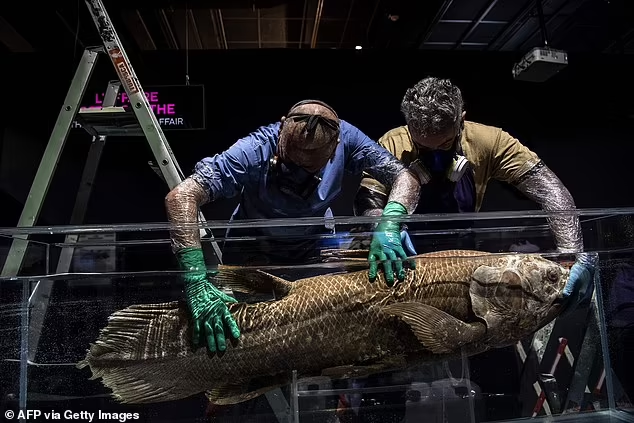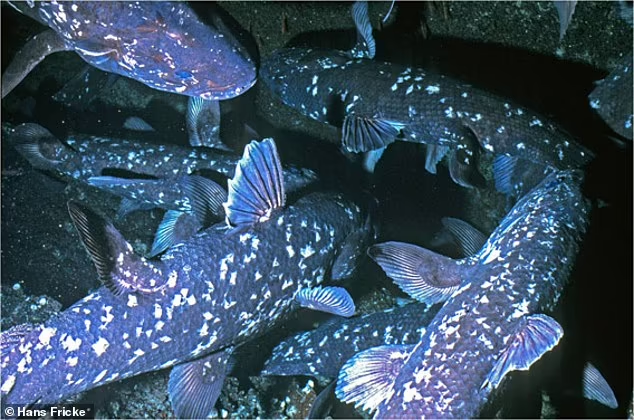In a discovery that stunned scientists and ignited awe among lovers of nature and animals, a living population of coelacanths — a 420-million-year-old species once believed to be extinct — has been found off the coast of Madagascar. Often dubbed “living fossils,” these rare creatures have survived mass extinctions, ice ages, and the rise and fall of dinosaurs. Their unexpected reappearance is nothing short of a biological rescue story from deep time.
A Prehistoric Creature Rises from the Depths
The remarkable finding came by chance when shark hunters in southwestern Madagascar set deep gillnets in the Indian Ocean. Instead of catching sharks, they hauled up one of the planet’s most ancient fish — the coelacanth (Latimeria chalumnae). Known for its unique limb-like fins and spotted scales, the coelacanth can grow up to 7 feet long and weigh nearly 200 pounds.
Researchers reported their findings in the South African Journal of Science, noting that these deep-set nets, designed for catching sharks, had unexpectedly revealed a thriving — yet fragile — coelacanth population.
“We were astounded by the numbers,” said Andrew Cooke, Managing Director of RESOLVE sarl, who led the study. “Even though there’s been no proactive conservation process in Madagascar, we’ve confirmed at least 34 specimens captured since 1987. Madagascar may be the epicenter of this ancient species.”
Nature’s Hidden Time Capsule
The coelacanth is unlike any modern fish. With its four limb-like fins, it once represented an evolutionary bridge between marine life and land animals — a living reminder of how early vertebrates might have taken their first steps onto land.
Nicknamed “Old Fourlegs,” the coelacanth’s biology still fascinates scientists. Modern imaging revealed that it carries a vestigial lung — a leftover from its prehistoric ancestors who once inhabited shallower seas over 400 million years ago. Though this lung no longer functions, it hints at how the fish’s ancient relatives adapted to different environments during Earth’s turbulent evolution.
📖 Full Story: Man Loses 360 Pounds Naturally—Internet Rallies to Support His Next Step
The Threat from Modern Fishing
Despite their deep-sea habitat, coelacanths face growing danger from gillnet fishing, a technique that has advanced dramatically since the 1980s due to the global demand for shark fins and oils. These powerful nets can reach depths of 330 to 1,600 feet (100–300 meters) — the very zone where coelacanths dwell.
As shark hunting intensified, so did the accidental capture of these “living fossils.” Cooke’s research suggests that more than 100 coelacanths may have been caught unintentionally over recent decades.
“The development of deep-set gillnets has led to an explosion of coelacanth captures in the Indian Ocean,” the researchers wrote. “Without intervention, their survival could again be at risk.”
Madagascar: A Living Museum of Evolution
While Cooke’s study highlights Madagascar as a potential stronghold for the coelacanth, some scientists believe the real epicenter might stretch further north, along the Mozambique-Tanzania coastline.
Dr. Tony Ribbink, former head of the African Coelacanth Ecosystem Program, urged further study:
“The Madagascar population is vital, but vast marine canyons northward may hold even greater numbers. Until we explore those regions, the picture remains incomplete.”
Regardless of location, the discovery reinforces Madagascar’s reputation as a biodiversity treasure trove — home to species that have defied extinction through sheer adaptability.

A Rescue Mission for the Ages
Once thought to have vanished 65 million years ago, the coelacanth made its first modern reappearance in 1938 off the coast of South Africa. That single find revolutionized evolutionary science. Now, with multiple populations confirmed, conservationists see an urgent need for protection programs tailored to this ancient survivor.
Modern coelacanths can live up to 48 years, reproduce slowly, and inhabit specific deep-sea canyons. These traits make them especially vulnerable to overfishing and habitat disturbance. Conservationists call for immediate international efforts to protect their fragile ecosystems from deep-sea exploitation.
📖 You Might Also Like: The Hidden Meaning Behind Princess Diana’s Cannes Gown — A Heartfelt Farewell to Grace Kelly
The Science Behind the Survival
The coelacanth’s survival across 420 million years is a mystery wrapped in scales and fins. Scientists believe its success lies in slow metabolism, deep-water isolation, and an environment that has remained stable for millennia.
New genetic studies are shedding light on how this fish avoided extinction while almost every other prehistoric species vanished. Its DNA provides crucial insights into early vertebrate evolution — how fins became limbs, and how lungs developed before animals moved onto land.
“The coelacanth is like a time capsule,” one researcher commented. “Every specimen helps us look back into our own evolutionary story.”
Guardians of Nature’s History
For now, the coelacanth remains both a scientific marvel and a conservation challenge. As modern fishing, pollution, and climate change threaten its deep-sea refuge, researchers stress the need for urgent international collaboration.
Protecting these ancient fish means preserving one of the last living connections to a world that existed before dinosaurs walked the Earth. It’s a chance to ensure that this rescue of evolution continues — that nature’s most ancient witness remains alive for future generations to study and admire.


